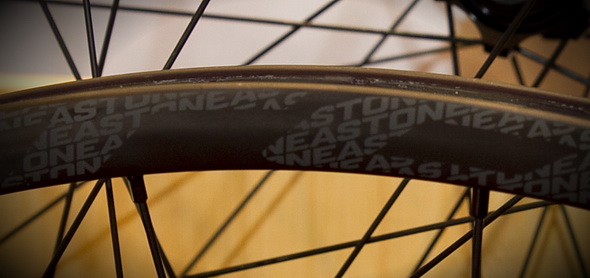
Suspension stems have been a divisive topic in mountain biking for some time. Between the Girvin Flexstem and the Softride suspension stem, there have been several attempts but never a solid option. Redshift is taking a unique approach toward designing and marketing their take on a suspension stem. The company is made up of a collective of engineers who come up with an idea, put it up on Kickstarter, and let consumers decide what gets made and what doesn’t. So far, every project they have put up has been successfully funded. This crowdfunding approach has allowed them to think a bit outside the box and thus introduce products like the ShockStop stem.


The ShockStop suspension stem includes five different elastomers to tune the compression. Inside the stem, there are two elastomers to customize the feel of the stem. With an effective travel of 20mm for drop bars, and 10mm for flat bars, the ShockStop is available in lengths from 90mm to 120mm with +/-6 degree angle, as well as a +/-30 degree option in the 100mm length. It uses a standard 31.8mm bar clamp, and has a max rider weight of 300lbs. (135kg.) and retails for $139.99.
I will admit I was immediately skeptical of the ShockStop stem. From years of wrenching in bike shops, I have ridden both the Girvin and Softride stems. They were both creaky, unreliable, and tended to move when you didn’t want them to. I was fully expecting the ShockStop to be a slightly nicer-looking version of the suspension stems of yore. However, with a weight from 264g to 298g, I was interested in seeing how it compared up to a traditional suspension fork. I wanted to see if Redshift’s claims actually held up on the trail.

Once I received the box from Redshift, I was immediately attracted to the finish of the stem, mainly the fact that it looks like a regular stem. At 264g for the 90mm +/+ 6 degree version, it is a little heavier than what I am used to, but not a deal breaker.
After reading the owners’ manual, it quickly became apparent that the installation is a bit more involved than a typical stem. The manual has a handy guide for choosing the elastomers for your riding weight. The stem includes five different elastomers, and the guide has different suggestions depending on your weight as well as if you’re using flat or drop bars. I dialed mine in for 155lbs. riding weight and drop bars. To install the elastomers, you remove the face plate, install the elastomers in the top two slots, then push the stem down and thread the preload bolt in to set everything in place. Once you install the bar, you are ready to go.


I tested the stem on a Salsa Cutthroat, and immediately noticed an obvious squish when pushing the bar down. It looks and feels a bit odd when you first play around with it. I took the bike out for the first test ride, and was happily surprised the stem disappeared underneath me. When riding on pavement or gravel, the stem felt fine at the recommended setting.
Once I took it out for the first short singletrack ride, I quickly realized that I needed to go to a slightly lower setting. Now at a softer setting, I took the bike out for a 30-mile, rooty, rocky trail ride. The stem soaked up a lot of the chatter I normally felt on a rigid bike, but never moved when I didn’t want it to. The flex in the stem also added a “preload” sensation when jumping the bike. I never felt any lateral play, nor flex when climbing out of the saddle.
The ShockStop stem has performed flawlessly on every ride I have taken it on. It has allowed me to add a little suspension to a superlight race bike, without adding the weight of a traditional suspension fork. I have found that I can ride the bike faster and with more confidence than before. The stem preloads when riding into berms, and soaks up hard impacts from drops. It also handles concurrent bumps and rocky terrain incredibly well without feeling out of control. It is as much at home on singletrack as it is on gravel. I am extremely eager to use the stem on longer bikepacking trips, as it has already helped immensely with hand numbness after long rides.

I went into this test with nothing but skepticism. I was expecting the stem to feel floppy and to negatively affect bike handling, so I was thrilled when I found that every single concern I had was unfounded. The ShockStop is a perfect addition to almost any rigid bike, whether it is an XC race bike, rigid singlespeed, or bikepacking rig. It adds just enough suspension to help soften the blow associated with riding on rough terrain. I am so impressed with the ShockStop, that I plan to pick another one up for my gravel bike, Redshift clearly took their time, and did their research when designing this stem, and I am eager to see what other tricks they have up their sleeves.





















8 Comments
May 31, 2018
May 31, 2018
May 24, 2018
Even though I diagnosed the flaw in my technique the numbness is quick to comeback.
May 31, 2018
1. Why 10 mm travel for flat bars and 20 mm for drop bars?
2. How does it feel when you stand to climb?
May 31, 2018
As far as climbing, if you push down hard you will feel it. It has no vertical movement when pulling up. Any movement when climbing is pretty negligible.
May 24, 2018
Jun 1, 2018
It is probably obvious, but worth pointing out -- this is comfort suspension, not control suspension.
Aug 19, 2018
Or else: is a rigid fork/Redshift combo equal as a suspension fork? Should safe some weight!!